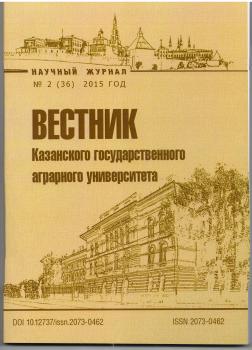Russian Federation
Russian Federation
Russian Federation
CSCSTI 68.29
Complex studies were conducted in eight-field grain-steam-crop and grain-steam-tilled crop rotations using the following terms: fertilizer systems, plant protection, basic tillage methods and plastic varieties. Scientific novelty lies in the fact that for the first time in the forest-steppe of the Volga region, on a systemic basis, resource-saving technologies have been developed on the basis of fertile crop rotations in an ecologically balanced, biologized farming system. Agroecological principles of conservation and reproduction of gray forest soil fertility and obtaining a planned harvest of high quality. Experimental substantiation of the role of action and interaction of the main factors of saving technology, in increasing crop productivity of crop rotations, productivity of arable land and soil fertility. Agroeconomic evaluation of the resource-saving technology effectiveness. Crop rotations of leguminous crops and perennial legumes increase the productivity of arable land to 15-20%, provide a positive balance of humus (0.45-0.5 tons per hectare). Organomineralic fertilizer system reduces the need for mineral fertilizers by 2-3 times, ensures the receipt of planned high quality harvest and reproduction of soil fertility. The integrated plant protection system, using biological means and methods, provides a saving of plant protection products to 30-35%, raises productivity to 15-25%. Moisture-resource-saving mode of soil cultivation (mulching various deep loosening without turnover of beds) allows to save 25-35% of fuel and reduce the moisture loss to 35-40%. Complex application of these factors with the use of high-yielding plastic varieties makes resource-saving technology that increases the productivity of cultivated crops and the productivity of arable land by 1.5-2 times, the profitability of production by 30-50% and ensuring the reproduction of soil fertility.
crop rotation, fertilizer, productivity, plowing, profitability, productivity of arable land.
Современная система земледелия должна быть адаптивно-ландшафтной, базирующейся на бережливости, энерго- и ресурсосбережении, воспроизводстве плодородия почв и экологической сбалансированности. Чтобы достичь этого, необходимо решение двух проблем, которые существуют в настоящие время. Первая из них – сохранение и воспроизводство плодородия почв. Проблематичность данного вопроса заключается в том, что в Республике Татарстан ежегодные потери гумуса почвами составляют от 450 до 1100 кг/га в зависимости от степени эродированности почв. Более 40% пашни подвержены в той или иной степени эрозии, за счет последней теряется 650-690 тыс.тонны гумуса, для восполнения которого ежегодно требуется вносить не менее 7 т/га пашни органических удобрений, а для расширенного воспроизводства плодородия почв – 9-12 т/га пашни в год. К сожалению, в республике внесение органических удобрений составляет всего лишь 1,4-1,5 т/га пашни. Баланс гумуса по республике отрицательный – 0,3 т/га [1]. Это первая проблема.
Вторая проблема – удорожание энергоносителей сделало технологии многозатратными, более того низкие закупочные и рыночные цены на зерно и другие продукты привели к диспаритету цен. В таких условиях, чтобы рентабельно работать, необходимо улучшение технологии производства растениеводческой продукции, сделав её ресурсосберегающей, обеспечивающей получение планируемого урожая импортозамещающего по качеству и воспроизводство плодородия почв.
В.И.Кирюшин и А.Л.Иванов отмечают, что создание систем земледелия и агротехнологий нового поколения, сохранения и воспроизводство почвенного плодородия не могут быть решены без разработки адаптивно-ландшафтных систем земледелия [2]. Наиболее важным направлением реусурсосбережения и снижения затрат в земледелии является переход на приоритетную основу в распределении ограниченных ресурсов для достижения цели. При этом первостепенное внимание должно быть уделено переводу земледелия на адаптивно-ландшафтную основу [3]. Важно изучение основных звеньев земледелия в зональном разрезе на адаптивно-ландшафтной основе [4]. Следовательно, успешное решение вышеуказанных проблем возможно на базе адаптивно-ландшафтной системы земледелия с комплексным применением следующих основных факторов земледелия:
- плодосменные севообороты;
- широкое использование в севооборотах бобовых культур как фактора биологизации земледелия, усиления роли биологического азота за счет расширения посевных площадей и видового разнообразия многолетних трав;
1. Chekmarev P.A. Spravochnik agrokhimika Respubliki Tatarstan. [Directory of the agrochemical of the Republic of Tatarstan]. / P.A. Chekmarev, A.A Lukmanov, S.Sh. Nuriev and others. - Kazan, 2015 - P. 322.
2. Agroekologicheskaya otsenka zemel, proektirovanie adaptivno-landshaftnykh sistem zemledeliya i agrotekhnologiy: Metodicheskoe rukovodstvo. / Pod redaktsiey Kiryushina V.I., Ivanova A.L. [Agroecological assessment of lands, design of adaptive landscape systems of agriculture and agrotechnology: Methodological guidance]. - M.: Rosinformagrotekh, 2005. - P. 784.
3. Matyuk N.S., Mazirov M.A. Perspektivy ispolzovaniya resursosberegayuschikh tekhnologiy v selskom khozyaystve Rossii. / N.S. Matyuk, M.A.Mazirov. “Resursosberegayuschie tekhnologii dlya zemledeliya i zhivotnovodstva Vladimirskogo OPOLYA”. Sbornik dokladov Vserossiyskoy nauchno-prakticheskoy konferentsii GNU VNIISKh Rosselkhozakademii. (Prospects for the use of resource-saving technologies in Russia’s agriculture. / “Resource-saving technologies for farming and animal husbandry in Vladimir Opolya”. Collection of reports of All-Russian Scientific and Practical Conference of the Russian Academy of Agricultural Sciences). Suzdal, 17-19 iyulya 2008. - P. 27-36.
4. Shakirov R.S., Askhadullin Kh.G. Resursosberegayuschaya tekhnologiya - strategicheskoe napravlenie adaptivno-landshaftnykh sistem zemledeliya. / R.S. Shakirov, Kh.G. Askhadullin // “Resursosberegayuschie tekhnologii dlya zemledeliya i zhivotnovodstva Vladimirskogo OPOLYA”. Sbornik dokladov Vserossiyskoy nauchno-prakticheskoy konferentsii GNU VNIISKh Rosselkhozakademii. (Resource-saving technology - strategic direction of adaptive-landscape systems of agriculture. // “Resource-saving technologies for farming and cattle-breeding in Vladimir Opolya”. Collection of reports of All-Russian Scientific and Practical Conference of the Russian Academy of Agriculture). Suzdal, 17-19 iyulya, 2008. P. 37-42.
5. Dospekhov B.A. Metodika polevogo opyta. [Methodology of field experience]. / B.A. Dospekhov. - M.: Kolos, 1979. - P. 416.





